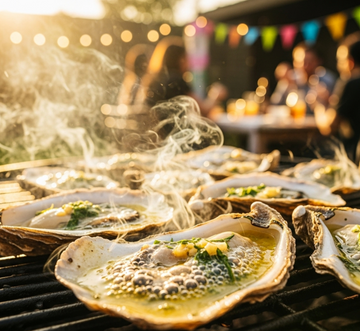Hosting an oyster tasting is a memorable way to share the ocean's bounty with friends and family. Whether you're an oyster aficionado or introducing them to newcomers, careful planning can turn a simple gathering into a fantastic culinary event. This guide provides all the tips and tricks you'll need to make it a hit.
Your Oyster Tasting Checklist
For a quick overview, follow these key steps for a successful event:
-
Select a diverse range of oysters (e.g., East and West Coast).
-
Store and prepare the oysters correctly for freshness and safety.
-
Plan for shucking, including the right tools and alternatives.
-
Prepare classic accompaniments and beverage pairings.
-
Create an engaging and educational experience for your guests.
Step 1: Curate Your Oyster Selection
Variety is key to a great tasting. Aim to showcase a range of flavors and textures.
-
East Coast vs. West Coast: Be sure to select oysters from both coasts to highlight their classic differences. East Coast oysters are typically brinier, while West Coast varieties tend to be sweeter and creamier. For example, include Blue Points from Long Island Sound and Kumamotos from Humboldt Bay.
-
Regional & Harvest Diversity: Choose oysters from different regions within each coast to showcase more subtle nuances in taste. You can also include both wild-caught and farm-raised oysters.
Step 2: Proper Oyster Storage and Preparation
Freshness and safety are paramount.
-
Storage: Keep your oysters cold in the refrigerator, but do not freeze them. Cover them with a damp cloth and plan to consume them within a few days of purchase for the best quality.
-
Cleaning: Before shucking, rinse the oysters under cold running water and gently scrub the shells to remove any debris.
Step 3: Plan for Shucking (and Its Alternatives)
The main event of preparing oysters requires the right tools and technique.
-
Tools: You will need a good oyster knife and a sturdy glove or towel to protect your hand.
-
Technique: Practice inserting the knife into the oyster's hinge and twisting to pop the shell open.
-
Alternatives: If you're intimidated by shucking, you can steam or grill the oysters. They will open on their own once they are cooked.
Step 4: Perfect Your Presentation and Pairings
How you serve the oysters is just as important as the oysters themselves.
-
Presentation: Serve the oysters on a bed of crushed ice to keep them cold. If you don't have ice, a large pile of salt also makes for a nice presentation.
-
Accompaniments: Provide a variety of classic condiments, such as lemon wedges, mignonette sauce, hot sauce, and horseradish. It's also a good idea to offer some oysters plain so guests can enjoy their natural flavor.
-
Beverage Pairings:
-
Wine: A crisp white wine like Sauvignon Blanc or Champagne pairs beautifully with oysters.
-
Beer: A light lager or a stout can also complement the briny and sweet notes of the oysters.
-
Non-Alcoholic: Sparkling water with a splash of citrus is a great option to refresh the palate.
Step 5: Elevate the Guest Experience
Add educational and interactive elements to make your tasting more engaging.
-
Educate Guests: Provide informational cards detailing each oyster's origin and flavor profile. You can also encourage guests to take tasting notes to make the event more interactive.
-
Engage with Activities: A live shucking demonstration can be both entertaining and educational. You could also incorporate fun oyster trivia to entertain your guests.
-
Set the Mood: Use nautical-themed decor to create a fitting ambiance. Playing soft background music, like light jazz or ocean sounds, can also help set a relaxing mood.
Frequently Asked Questions (FAQ)
How should I store oysters before a tasting?
Store oysters in the refrigerator, covered with a damp cloth, to keep them cold but not frozen. They should be eaten within a few days of purchase.
What should I serve with oysters?
Classic accompaniments include lemon wedges, mignonette sauce, hot sauce, and horseradish.
What is the best wine to pair with oysters?
Crisp white wines, such as Sauvignon Blanc, or Champagne are excellent pairings for oysters.
How can I open oysters if I don't know how to shuck?
For an easy alternative to shucking, you can steam or grill oysters until they open on their own.


